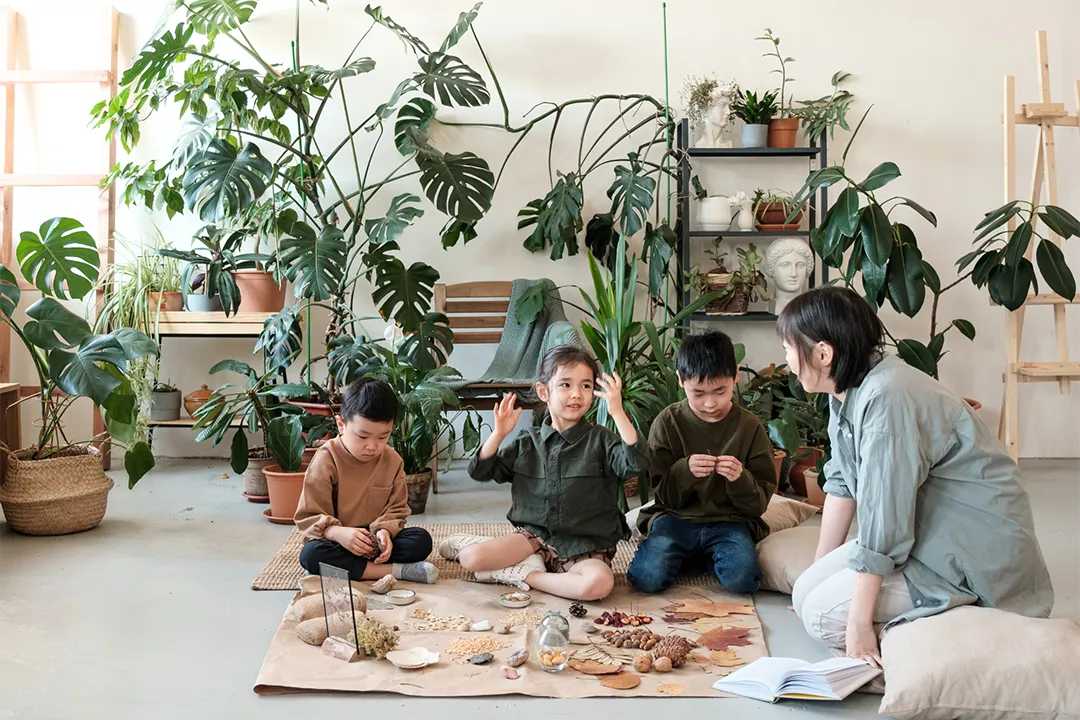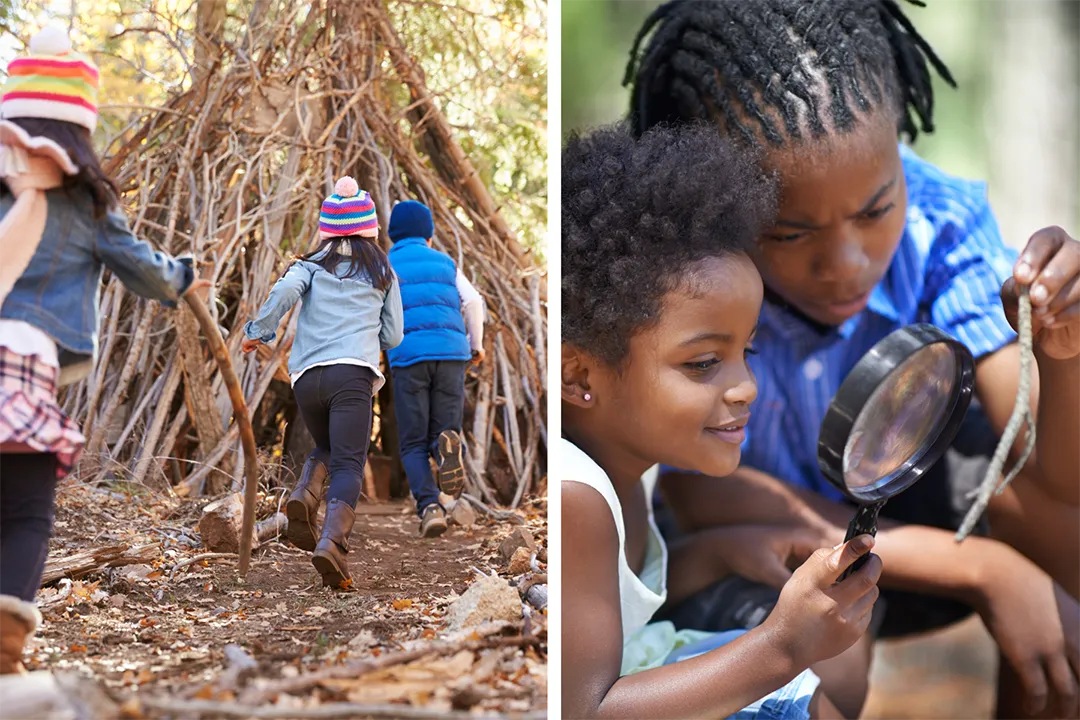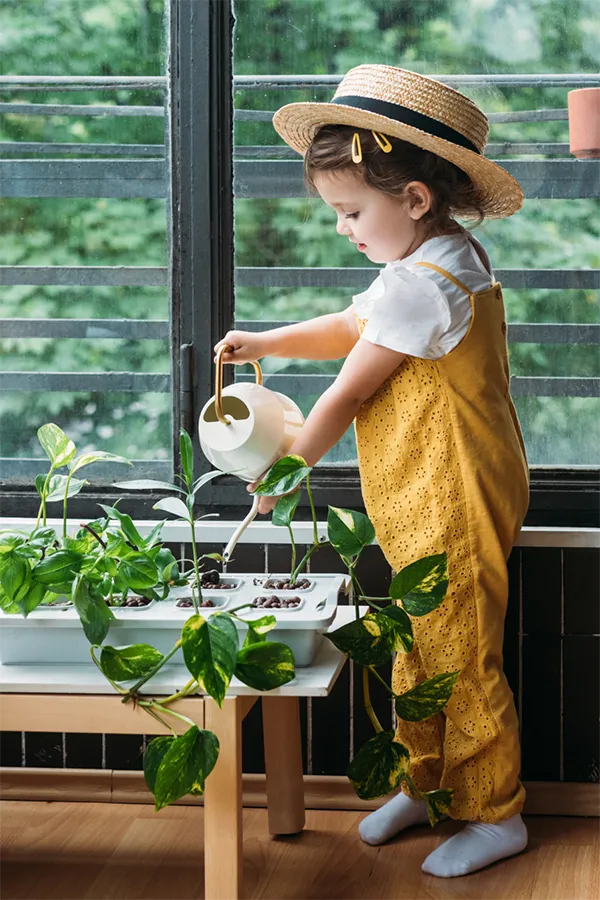Children were made for the outdoors. They learn by touching, climbing, exploring, and imagining in wide-open spaces. But in today’s world, kids are spending more time indoors than ever before. Schools, daycare, libraries, and homes are often designed for efficiency rather than sensory experience. The results? Rising stress levels, shortened attention spans, and less physical movement.
That’s where interior landscaping comes in. We believe every indoor environment—whether it’s a classroom, pediatric clinic, or children’s museum—should support growth, health, and imagination. And research shows that integrating natural elements into these spaces can have profound benefits for child development.

What science says about nature and child development
The evidence is clear: access to nature helps children thrive in every area of development. A study from the University of California, Davis found that nature-based environments improve children’s social-emotional skills, supporting self-regulation, confidence, and empathy. Meanwhile, Virginia Tech research shows that outdoor play in green spaces enhances motor development, cooperation, and focus.
But perhaps most striking are the cognitive benefits. This Minnesota study discovered that nature-based learning improves children’s sustained attention, especially in upper elementary grades. This is echoed by researchers in Iowa, who found that nature play increases creative thinking, problem-solving, and overall curiosity. In short, children are wired to respond positively to living systems. And interior landscaping is one of the most powerful ways to bring those systems indoors.

Interior landscaping brings nature inside
When natural play isn’t available, interior landscaping offers a powerful alternative. It connects children with greenery in the very places they spend most of their time: schools, healthcare clinics, community centers, and homes.
What does that look like in action? Here are some possibilities:
- A lush green wall in a school hallway provides visual calm and natural color
- Potted indoor trees in a daycare reading nook spark imaginative play
- Hanging plants in a library clean the air and soften acoustics
- MossWallArt™ in therapy rooms helps children self-regulate
When placed intentionally, interior landscaping doesn’t just decorate a space—it transforms the experience of being inside it.
A remedy for the setbacks of indoor childhoods
Grand Valley research shows that children who regularly interact with nature experience less anxiety, fewer behavioral issues, and more robust physical health. But in desert cities like Phoenix, extreme heat and sprawling development often limit access to outdoor nature. This makes interior landscaping especially valuable.
Because we human beings are derived from nature, recreating aspects of the natural world indoors offers us:
- Sensory experiences that calm overstimulated nervous systems
- Opportunities for movement and engagement through plant care activities
- Visual and tactile variety that reduces environmental monotony
- Biophilic design elements that promote belonging and comfort
In a world of screens and sterile surfaces, interior landscaping helps children feel grounded and alive.
Interior landscaping in schools and educational spaces
From preschool classrooms to university study lounges, interior landscaping supports the kind of learning that sticks. It’s been proven that children learn best in environments where nature is part of the daily routine (Illinois State University study). Natural elements boost focus and memory retention, particularly for students who struggle in traditional settings.
At Plant Solutions, we can work with school designers, educators, and architects to implement interior landscaping that:
- Improves indoor air quality and reduces illness-related absences
- Introduces plant-based learning opportunities and responsibility
- Reduces noise and supports quiet, focused study areas
- Reinforces sustainability lessons through real-life greenery
When learning environments include interior landscaping, students don’t just perform better—their bodies and minds feel better.

How interior landscaping supports children in healthcare settings
Medical spaces can be stressful, especially for children. The unfamiliar smells, bright lighting, and long waits create a sense of unease. But with thoughtfully placed interior landscaping, we can shift the emotional tone of these spaces.
Aside from visual beauty, pediatric clinics and therapy offices use greenery for three common purposes:
- The presence of nature soothes anxiety before appointments
- Nature can serve as a tool to support attention and behavior regulation during therapy
- Natural elements offer a sensory anchor for neurodivergent children
This isn’t a theory; it’s backed by science. A 2022 study by California State found that green indoor spaces promote emotional well-being and physical movement, both essential in child development. We believe every healthcare environment deserves interior landscaping that makes children feel safe, curious, and empowered.
The role of adults in rewilding children — better childhoods with biophilic design
As leaders in biophilic design, our mission is to use interior landscaping not as filler, but as function. We understand how deeply children are affected by their surroundings, and understand that every planter, every vine, every living wall should serve a purpose. In our most recent projects, we’ve installed moss wall art in hospitals to support sensory processing and created lobby plant installations that reduce anxiety for families waiting for service. It’s about creating more than beauty — it’s about designing for well-being.
The benefits of nature aren’t limited to children. When we invest in interior landscaping for kids, we improve the emotional tone of everyone in the room, from parents and teachers to therapists and administrators. As adults, we shape the spaces children inhabit. When we prioritize living, breathing systems over synthetic ones, we send a message: you matter, and this place is meant to support you. That’s what interior landscaping does. It tells a story of care, presence, and hope.

We know that kids don’t need perfection—they need places where they can connect, imagine, and grow. Children benefit more from supportive and engaging environments than from overly polished or pristine ones. Luckily, our interior landscaping expertise allows us to create places that are nurturing, meaningful and beautifully designed.
A child who grows up surrounded by nature—even indoors—grows up more grounded, more attentive, and more connected to the world around them. If you’re ready to bring nature back into the spaces where children learn, heal, and play, we’re here to help. Let’s transform your interior space so kids can flourish from the ground up.
Ready to cultivate an environment where children thrive?
Let’s discuss how our interior landscaping solutions can bring the benefits of nature to your space.
